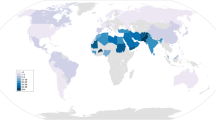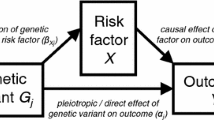Abstract
Past methods for estimating the population frequency of familial cancer syndromes have used cases and controls ignoring the familial nature of genetic disease. In this study we modified the capture–recapture method from ecology to estimate the number of families in central Ohio with Lynch syndrome (LS). We screened 1566 colorectal cancer cases and 545 endometrial cancer cases in central Ohio from 1999 to 2005 and identified 58 with LS. We screened an additional 3346 colorectal and 342 endometrial cancer cases from 2013 to 2016 and identified 149 with LS. We found 12 LS mutations shared between families observed in the first and second studies. We identified three individuals between studies who were closely related and eight who were more distantly related. We used identified family relationships and genetic test results to estimate family size and structure. Applying a modified capture–recapture method we estimate 1693 3-generation families in the area who have 288 unique LS causing mutations. Comprehensive colorectal and endometrial cancer screening will take about 20 years to identify 50% of families with LS. This is the first time that the capture–recapture method has been applied to estimate the burden of families with a specific heritable disease. Family structure reveals the potential extent of prevention and the time necessary to identify a proportion of families with LS.

Similar content being viewed by others
References
Carayol J, Khlat M, Maccario J, Bonaïti-Pellié C (2002) Hereditary non-polyposis colorectal cancer: current risks of colorectal cancer largely overestimated. J Med Genet 39:335–339
Pearlman R, Frankel WL, Swanson B et al (2017) Prevalence and spectrum of germline cancer susceptibility gene mutations among patients with early-onset colorectal cancer. JAMA Oncol 3:464–471. https://doi.org/10.1001/jamaoncol.2016.5194
Yurgelun MB, Allen B, Kaldate RR et al (2015) Identification of a variety of mutations in cancer predisposition genes in patients with suspected Lynch syndrome. Gastroenterology 149:604–613.e20. https://doi.org/10.1053/j.gastro.2015.05.006
Haraldsdottir S, Rafnar T, Frankel WL et al (2017) Comprehensive population-wide analysis of Lynch syndrome in Iceland reveals founder mutations in MSH6 and PMS2. Nat Commun 8:14755. https://doi.org/10.1038/ncomms14755
Chen S, Wang W, Lee S et al (2006) Prediction of germline mutations and cancer risk in the Lynch syndrome. JAMA 296:1479–1487. https://doi.org/10.1001/jama.296.12.1479
Win AK, Jenkins MA, Dowty JG et al (2017) Prevalence and penetrance of major genes and polygenes for colorectal cancer. Cancer Epidemiol Biomark 26:404. https://doi.org/10.1158/1055-9965.EPI-16-0693
Hampel H, de la Chapelle A (2011) The search for unaffected individuals with Lynch syndrome: do the ends justify the means? Cancer Prev Res (Philadelphia) 4:1–5. https://doi.org/10.1158/1940-6207.CAPR-10-0345
Terdiman JP, Levin TR, Allen BA et al (2002) Hereditary nonpolyposis colorectal cancer in young colorectal cancer patients: high-risk clinic versus population-based registry. Gastroenterology 122:940–947
Kohlmann W, Gruber SB (1993) Lynch Syndrome. In: Adam MP, Ardinger HH, Pagon RA et al (eds) GeneReviews(®). University of Washington, Seattle, Seattle
Møller P, Seppälä T, Bernstein I et al (2017) Cancer incidence and survival in Lynch syndrome patients receiving colonoscopic and gynaecological surveillance: first report from the prospective Lynch syndrome database. Gut 66:464–472. https://doi.org/10.1136/gutjnl-2015-309675
Krawczak M, Cooper DN, Schmidtke J (2001) Estimating the efficacy and efficiency of cascade genetic screening. Am J Hum Genet 69:361–370. https://doi.org/10.1086/321973
Ladabaum U, Wang G, Terdiman J et al (2011) Strategies to identify the Lynch syndrome among patients with colorectal cancer: a cost-effectiveness analysis. Ann Intern Med 155:69–79. https://doi.org/10.7326/0003-4819-155-2-201107190-00002
Snowsill T, Huxley N, Hoyle M et al (2014) A systematic review and economic evaluation of diagnostic strategies for Lynch syndrome. Health Technol Assess Winch Engl 18:1–406. https://doi.org/10.3310/hta18580
Hampel H (2016) Genetic counseling and cascade genetic testing in Lynch syndrome. Fam Cancer 15:423–427. https://doi.org/10.1007/s10689-016-9893-5
Hampel H, Frankel WL, Martin E et al (2005) Screening for the Lynch syndrome (hereditary nonpolyposis colorectal cancer). N Engl J Med 352:1851–1860. https://doi.org/10.1056/NEJMoa043146
Hampel H, Frankel W, Panescu J et al (2006) Screening for Lynch syndrome (hereditary nonpolyposis colorectal cancer) among endometrial cancer patients. Cancer Res 66:7810–7817. https://doi.org/10.1158/0008-5472.CAN-06-1114
Hampel H, Frankel WL, Martin E et al (2008) Feasibility of screening for Lynch syndrome among patients with colorectal cancer. J Clin Oncol 26:5783–5788. https://doi.org/10.1200/JCO.2008.17.5950
Shia J, Tang LH, Vakiani E et al (2009) Immunohistochemistry as first-line screening for detecting colorectal cancer patients at risk for hereditary nonpolyposis colorectal cancer syndrome: a 2-antibody panel may be as predictive as a 4-antibody panel. Am J Surg Pathol 33:1639–1645. https://doi.org/10.1097/PAS.0b013e3181b15aa2
Petersen GJ C (1896) The yearly immigration of young plaice into the Limfjord From the German Sea. Rep Dan Biol Stn 6:1–48
Lincoln F (1930) Calculating waterfowl abundance on the basis of banding returns. US Dept Agric Circ 118:1–4
Tilling K (2001) Capture–recapture methods—useful or misleading? Int J Epidemiol 30:12–14. https://doi.org/10.1093/ije/30.1.12
Chapman DG (1951) Some properties of the hypergeometric distribution with applications to zoological sample censuses. University of California Press, Berkeley
Quehenberger F, Vasen HFA, van Houwelingen HC (2005) Risk of colorectal and endometrial cancer for carriers of mutations of the hMLH1 and hMSH2 gene: correction for ascertainment. J Med Genet 42:491–496. https://doi.org/10.1136/jmg.2004.024299
Bonadona V, Bonaïti B, Olschwang S et al (2011) Cancer risks associated with germline mutations in MLH1, MSH2, and MSH6 genes in Lynch syndrome. JAMA 305:2304–2310. https://doi.org/10.1001/jama.2011.743
Senter L, Clendenning M, Sotamaa K et al (2008) The clinical phenotype of Lynch syndrome due to germ-line PMS2 mutations. Gastroenterology 135:419–428. https://doi.org/10.1053/j.gastro.2008.04.026
Machiela MJ, Chanock SJ (2015) LDlink: a web-based application for exploring population-specific haplotype structure and linking correlated alleles of possible functional variants. Bioinformatics (Oxford) 31:3555–3557. https://doi.org/10.1093/bioinformatics/btv402
Clendenning M, Baze ME, Sun S et al (2008) Origins and prevalence of the American Founder Mutation of MSH2. Cancer Res 68:2145–2153. https://doi.org/10.1158/0008-5472.CAN-07-6599
Desai DC, Lockman JC, Chadwick RB et al (2000) Recurrent germline mutation in MSH2 arises frequently de novo. J Med Genet 37:646–652
Cancer of the Colon and Rectum - Cancer Stat Facts. https://seer.cancer.gov/statfacts/html/colorect.html. https://seer.cancer.gov/statfacts/html/colorect.html. Accessed 28 Sept 2017
Rañola JMO, Liu Q, Rosenthal EA, Shirts BH (2017) A comparison of cosegregation analysis methods for the clinical setting. Fam Cancer. https://doi.org/10.1007/s10689-017-0017-7
U.S. Census Ohio Population. https://www.census.gov/quickfacts/fact/table/OH/PST045216. https://www.census.gov/quickfacts/fact/table/OH/PST045216. Accessed 28 Sept 2017
Plazzer JP, Sijmons RH, Woods MO et al (2013) The InSiGHT database: utilizing 100 years of insights into Lynch syndrome. Fam Cancer 12:175–180. https://doi.org/10.1007/s10689-013-9616-0
Landrum MJ, Lee JM, Riley GR et al (2014) ClinVar: public archive of relationships among sequence variation and human phenotype. Nucleic Acids Res 42:D980–D985. https://doi.org/10.1093/nar/gkt1113
McCarty DJ, Tull ES, Moy CS et al (1993) Ascertainment corrected rates: applications of capture–recapture methods. Int J Epidemiol 22:559–565
McCrea RS, Morgan BJT (2015) Analysis of capture–recapture data, 1st edn. CRC Press, Boca Raton
Perez-Carbonell L, Ruiz-Ponte C, Guarinos C et al (2012) Comparison between universal molecular screening for Lynch syndrome and revised Bethesda guidelines in a large population-based cohort of patients with colorectal cancer. Gut 61:865–872. https://doi.org/10.1136/gutjnl-2011-300041
Marquez E, Geng Z, Pass S et al (2013) Implementation of routine screening for Lynch syndrome in university and safety-net health system settings: successes and challenges. Genet Med 18:45
Hunter JE, Zepp JM, Gilmore MJ et al (2015) Universal tumor screening for Lynch syndrome: assessment of the perspectives of patients with colorectal cancer regarding benefits and barriers. Cancer 121:3281–3289. https://doi.org/10.1002/cncr.29470
Acknowledgements
The Ohio Colorectal Cancer Prevention Initiative is supported by Pelotonia, http://pelotonia.org/. Brian Shirts and John Ranola are supported by Damon Runyon Cancer Research Foundation (DRR-33-15) and by development funds from the Fred Hutch/University of Washington Cancer Consortium (NCI 5P30 CA015704-39).
Author information
Authors and Affiliations
Corresponding author
Electronic supplementary material
Below is the link to the electronic supplementary material.
Rights and permissions
About this article
Cite this article
Ranola, J.M.O., Pearlman, R., Hampel, H. et al. Modified capture–recapture estimates of the number of families with Lynch syndrome in Central Ohio. Familial Cancer 18, 67–73 (2019). https://doi.org/10.1007/s10689-018-0096-0
Published:
Issue Date:
DOI: https://doi.org/10.1007/s10689-018-0096-0




